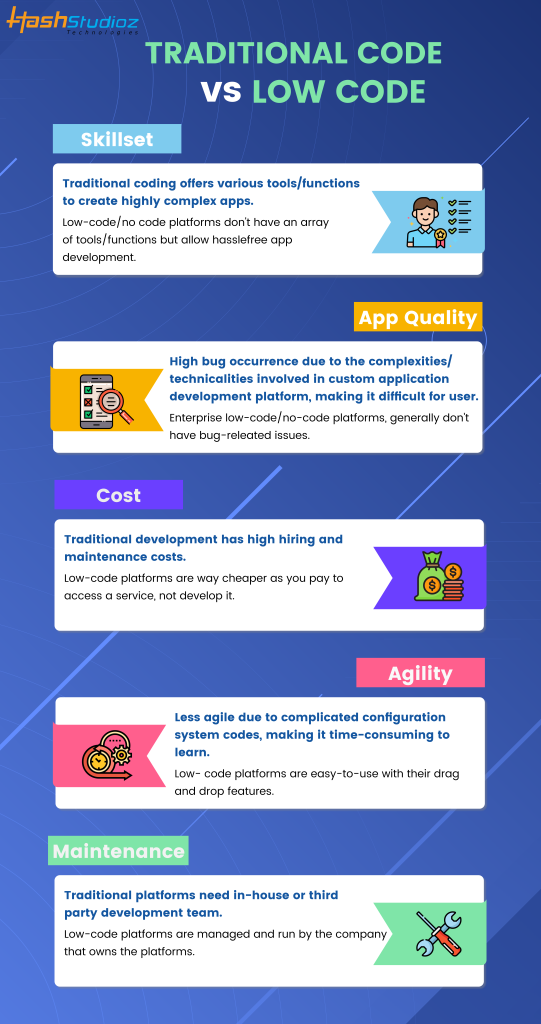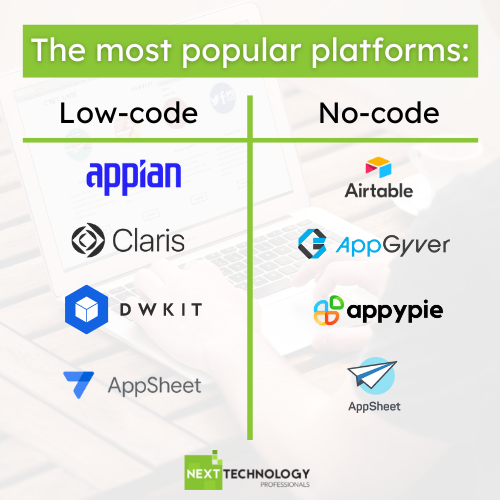Handy Tips To Selecting Low-Code Platform Examples
Benefits Of Low-Code Development In Terms Of SpeedVisual Development Environment:
Drag-and-Drop Interfaces: Low-code platforms provide visual tools for designing applications. Developers can utilize drag-and-drop tools to create applications quickly and without writing a large amount of code.
A lot of low-code platforms come with built-in templates and components that permit developers to quickly build prototypes of their applications and build them without having to start from scratch.
Reduced Coding Requirements
Automated code generation: Low-code platforms produce the codes that are used to build them based on visual models created and maintained by programmers. This eliminates the need to manually code and accelerates development.
Reusable Components: Developers are able to make use of reusable components across various projects, minimizing the time they spend writing and testing code.
Streamlined Collaboration:
Integration of Development Tools: Low-code tools usually come with tools for version control testing, deployment, and testing which facilitates seamless collaboration between development teams.
Citizen Development: Users of businesses as well as non-developers can help with application development using intuitive interfaces, which can reduce the bottleneck of development often caused by the lack of availability of professionals.
Rapid Iteration and Prototyping
Rapid Prototyping: Developers design prototypes quickly to validate ideas and gather feedback. This can result in a shorter iteration cycle.
Simple Modifications: The visual design of low-code programming makes it easy to make modifications and updates to applications. This speeds up the process of refining and improving applications based on user feedback.
Pre-built Integrations:
API Integrations. Low-code platforms typically come with pre-built connectors as well as APIs for the most popular services, which reduces the time needed to integrate other systems.
Data Integration: The built-in tools make it easier for connecting with databases and other sources, speeding up development.
Deployment & Scaling
One-Click deployment: A lot of platforms that use low-code offer an option to deploy applications, thus reducing time and effort.
Cloud-based solutions: Cloud platforms with low-code enable developers to focus on the design and function of their apps rather than worrying about the logistics of deployment.
Overall, low-code development has the advantage of speed due to its ability of automatizing and simplifying a variety of aspects of development. This allows for quicker delivery of apps and easier adapting to the changing demands. View the most popular Low-code Platform for application development info for website examples including app platforms, application development platforms, develop cross platform mobile app, cross platform mobile dev, rapid applications, push notifications android, azure sql databases, mobile app development platforms, microsoft azure sql, low code platforms and more.

The Benefits Of Developing Low-Code For Governance And Security
Low-code development has several benefits in terms of security and governance. These are crucial for ensuring applications are secure, compliant and well-managed through their entire lifecycle. Here are some of the most important advantages:
Unified Manage Console: Lowcode platforms typically have a management console which allows administrators to oversee and manage applications.
Role-Based Access Control (RBAC): These platforms typically include robust role-based access control, allowing administrators to define and enforce access policy. This allows only authorized users to modify or access certain parts of a program.
Compliance and Regulatory Adherence
A lot of low-code platforms come with built-in compliance features. They are built to comply with industry standards and regulations like GDPR or HIPAA. They provide frameworks and tools that ensure applications meet the specifications.
Audit Trails: Many organizations use comprehensive log and audit trail systems, which enable them to keep track of changes as well as track access, and ensure that they are in compliance with internal as well as external rules and regulations.
Improve Security Measures
Data Encryption : Low-code platforms typically provide built-in encryption of data at rest and during transit. This guarantees that sensitive information will be protected.
Security Certificates: Many low-code providers have a security certificate (e.g. ISO 27001 and SOC 2) which demonstrate they adhere to the strictest security guidelines. They offer an additional level of assurance to clients.
Automated updates for security:
Regular patches and updates Low-code platforms can handle the majority of security patches and updates in a way. They ensure that applications are secure from the latest attacks without requiring developers to intervene manually.
Security Monitoring - Continuous monitoring for security is often part of the program. It provides real-time insight and alerts about security risks that could be a threat.
Data Governance:
Data Access Policies These platforms enable organisations to create data access policies and enforce these policies to ensure that data is available only to users who are authorized. They also make sure that the data is used correctly.
Data Masking and Anonymization: The built-in tools to hide and anonymize data can help protect sensitive information in testing and development environments.
Consistent Application Management
Pipelines for development and deployment: Low-code platforms allow for integrated development, including security tests. This provides security throughout the lifecycle of an application.
Version Control. The integrated version management system helps to track and reverse any changes made to the application, while ensuring that the integrity of it is maintained.
User Authentication & Authorization
Single Sign-On: The support for SSO as well as other sophisticated authentication methods eases the management of users and increases security.
Multi-Factor Authentication: Many platforms have integrated support for multi-factor authentication. This provides an additional layer of security to applications.
Policy enforcement and Compliance Monitoring:
Low-code platforms are often designed with policies that are pre-defined to help organizations implement security and governance policies quickly.
Tools for Monitoring Compliance The tools offer constant monitoring and reports about compliance levels, making it easier to recognize and resolve possible issues in advance.
Integration into Existing Security Infrastructure:
Seamless Integrate: Low-code platform are designed to seamlessly integrate with existing security infrastructure and tools, including identity management solutions SIEMs (Security Information and Event Management Solutions), and firewalls.
API Security API Security Features: Built-in API security functions ensure that integrations with other systems are secure, protecting information and ensuring the integrity of the application.
Training and Best practices
Best practices: Many platforms provide guidelines for developing secure apps, as well as best practices. This helps non-developers to adhere to security standards.
Certain lowcode companies offer assistance and security training to users to help them understand how to build and maintain secure applications.
Overall, the application's governance and security advantages guarantee that applications are built and managed securely and in accordance with regulations and in control. These platforms provide the frameworks and tools necessary to secure sensitive data as well as enforce policies and ensure compliance with regulations while reducing managing and monitoring. Follow the recommended Enterprise application development with Low-code Platform for blog tips including sso azure, rapid app development, cross platform mobile app development, driver jdbc, cross platform app dev, rapid applications, database in azure, push notifications android, azure sql databases, low code platforms and more.

Low-Code Apps Can Provide Benefits In The Area Of Collaboration And Workflow
The low-code approach to development of applications provides numerous advantages in regards to workflow and collaboration, which makes it an ideal choice for companies looking to increase team efficiency and speed up their development processes. These are the primary advantages.
Unified Development Environment. Low-code platforms enable all team members to collaborate in a single, unifying environment. This includes business analysts, developers and designers as well as stakeholder. This helps to eliminate barriers and improve communication.
Visual Development Tools: The graphic drag-and-drop feature of low-code platforms makes it easy for non-technical team members to participate in the process of development, while ensuring that business requirements are accurately captured and implemented.
Communication Enhancement:
Real-Time Collaboration A number of low-code platforms offer real-time capabilities, like commenting and editing simultaneously, or immediate feedback. This allows for constant communication and can help reduce the amount of time wasted on back-and-forth discussions.
Shared Workspaces: Teams may collaborate in shared workspaces, which allows them to view the, edit and debate project components, ensuring everyone is on the same page and working towards common goals.
Streamlined Workflow Management:
Built-in project management Tools Lowcode platforms are often equipped with integrated tools that aid teams in planning, tracking and coordinating their progress. This includes task assignments, progress tracking, and management of deadlines.
Automating repetitive workflows and tasks decreases the chance of errors and manual work, allowing teams and individuals to focus on more important initiatives and boost efficiency.
Speedier iteration cycles:
Rapid Prototyping: Platforms that use low-code allow rapid prototyping and iterative design, allowing teams to develop tests, refine, and test applications over shorter periods of time. This means feedback can be quickly integrated and changes are made.
Support for Agile Methodologies Supporting agile practices gives teams the ability to work in sprints and continuously deliver small increments of functionalities that make it easier to adjust to changing requirements.
Accessibility for non-developers:
Citizen Development - Low-code platforms allow business users the capability to design and edit apps without coding expertise. This lets IT and development teams to focus on other projects and react faster to business demands.
Training and onboarding: Intuitive user interfaces and extensive resources for training aid in bringing new team members up to level. This enhances overall team's collaboration.
Centralized documentation and knowledge sharing:
Integrated documentation Platform features that are low-code usually allow you to create and manage documents within the platform. All project information is centrally accessible and easy to access.
Knowledge Repositories. Teams can set up repositories for knowledge, including templates and reusable parts. This can facilitate sharing of knowledge and will reduce duplicate work.
Standardization and Consistency:
Standardized components: Standardized components that are pre-built ensure consistency in applications. Team members are able to understand and work with greater ease with different components.
Governance and compliance Frameworks for governance and compliance that integrate help ensure that development conforms to organizational standards and regulatory requirements. This lowers the risk of non-compliance, as well as helping applications meet quality standards.
Feedback Loops and Improvement Loops
Integrated Feedback Mechanisms Low-code platforms usually have integrated feedback mechanisms that allow users to provide easy feedback on the application, which can then be incorporated into the process of development.
Continuous Improvement: The capability for software to rapidly iterate and make changes on the basis of feedback, ensuring that they are in line to the needs of the user and business objectives.
Visualization of Reporting
Real-Time Analysis Tools for reporting and analytics integrated into the software give real-time information on the progress of projects along with user interaction and overall performance. This enables an informed decision-making process based on data.
Visual Workflow Mapping: Visual tools for mapping workflows and processes helps teams to understand and improve their workflows, identifying gaps and areas to improve.
In terms of collaboration, low-code apps are an excellent way to simplify workflows, bring different teams together and automate tasks. This fosters a more collaborative, efficient, and agile development environment, which ultimately leads to better-performing applications and greater alignment with business objectives.
